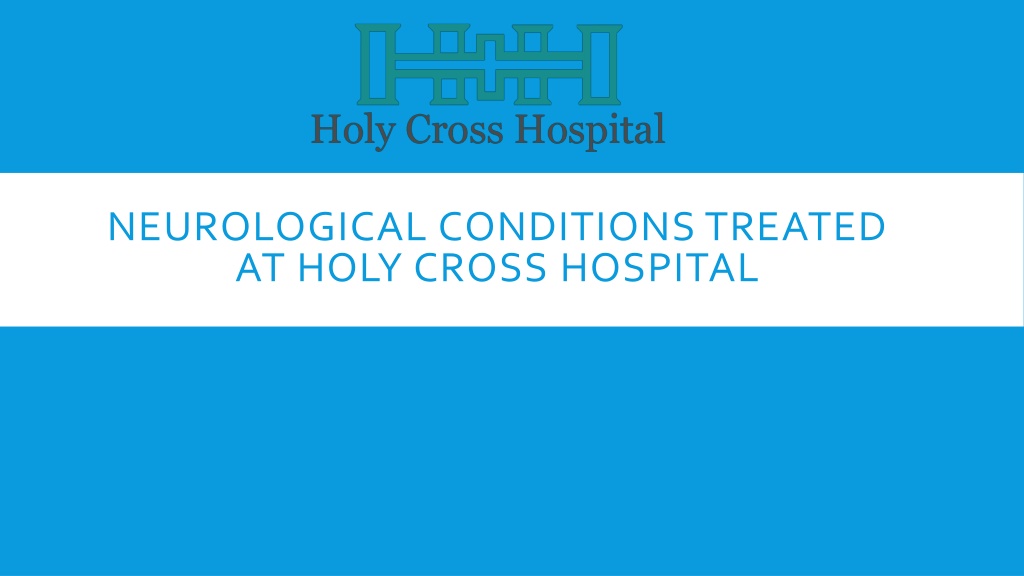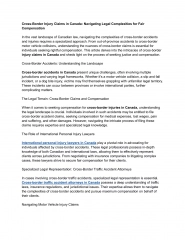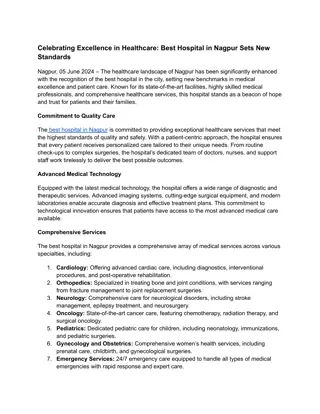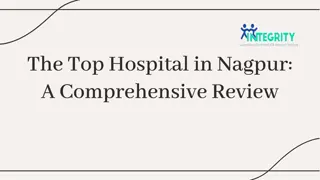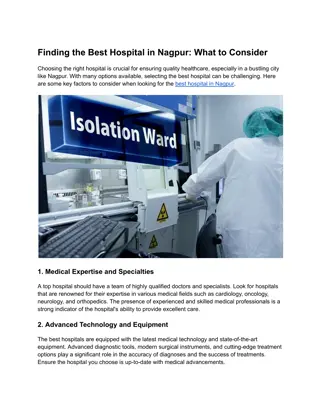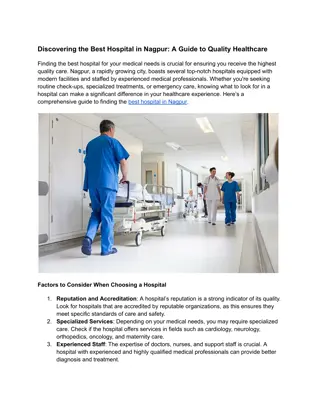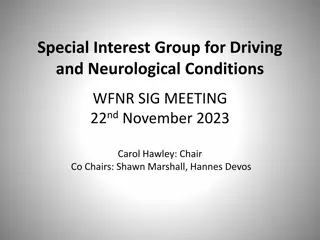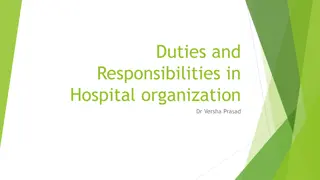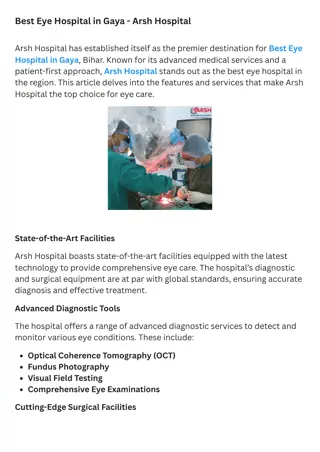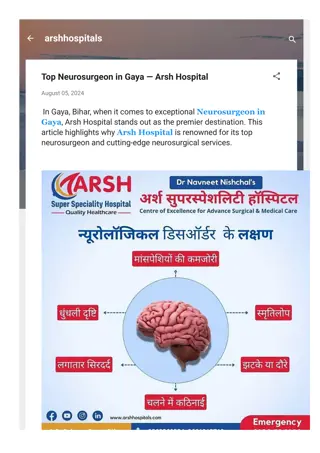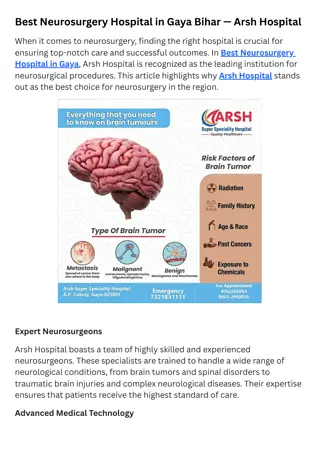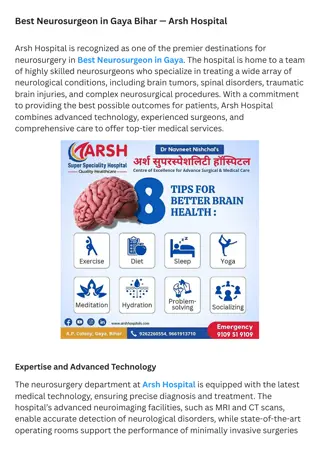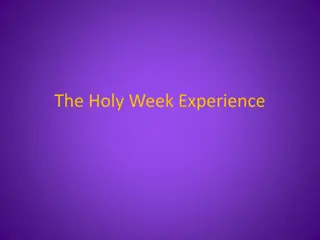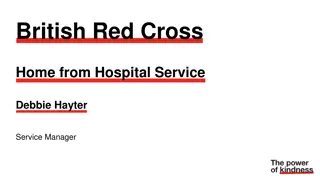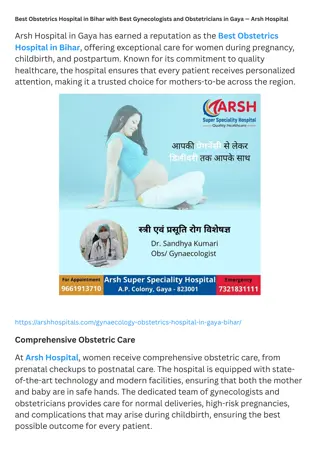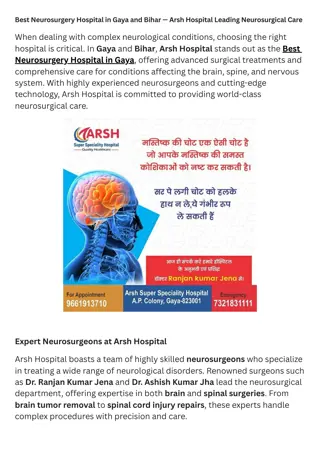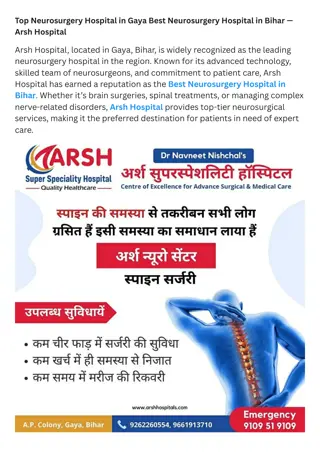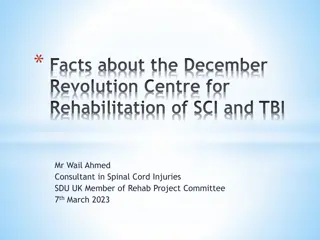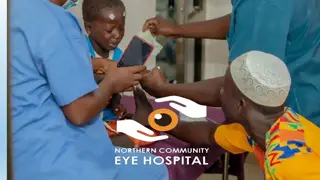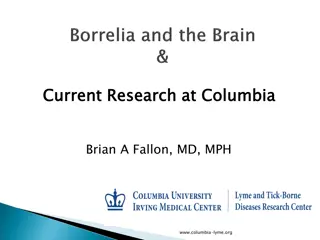Comprehensive Neurological Care at Holy Cross Hospital
This content provides detailed information on the neurological conditions treated and managed at Holy Cross Hospital, including stroke, acquired brain injury, multiple sclerosis, and more. It also discusses the key principles of care focusing on person-centered approaches and covers various aspects such as physical health, continence care, cognition, communication strategies, and more. The aim is to offer a holistic understanding of neurological conditions and how they are addressed at the hospital.
Download Presentation

Please find below an Image/Link to download the presentation.
The content on the website is provided AS IS for your information and personal use only. It may not be sold, licensed, or shared on other websites without obtaining consent from the author. Download presentation by click this link. If you encounter any issues during the download, it is possible that the publisher has removed the file from their server.
E N D
Presentation Transcript
NEUROLOGICAL CONDITIONS TREATED AT HOLY CROSS HOSPITAL
COURSE CONTENT AND AIMS To provide an understanding of the main conditions we treat at Holy Cross . The basic anatomy and physiology of these conditions. The common complications of these conditions. The Principles of person centred Care and our philosophy. Questions and Answer session. Further reading and training opportunities.
NEUROLOGICAL CONDITIONS MANAGED AT HOLY CROSS Stroke-Cerebral Vascular Accident Acquired Brain Injury -Traumatic and Hypoxic Muscular Dystrophy Multiple Sclerosis Motor Neurone Disease Spinal Cord Injury Guillain Barre Syndrome Hydrocephalus Epilepsy
KEY PRINCIPLES OF CARE At Holy Cross we provide Person Centred Care Understanding the Person needs and preferences to deliver the best care possible, with respect and compassion. How do we achieve this The person is central to all our interventions. We take into account the persons preferences, past and present The patient profiles Getting to know me helps us achieve this as well as working and listening to our patients and their family and friends. We work as a Team to provide a consistent approach to patient care. 1. Physical Health Understand the Physical Health needs of the person, both the Primary and Secondary conditions. The risk and management of the person with the condition e.g. monitoring diabetes, temperature control, infection, epilepsy , shunt blockage, spasm, pain, fatigue etc. 2. Continence care Bowel and urine output management interventions / risk 3. Skin Vulnerability, pressure issues, equipment interventions / risk 4. Mobility Moving and handling, equipment, posture and positioning - risk 5. Behaviour Fatigue, triggers ABC charts, Verbal and Physical abuse / injury / risk behaviours to others or self
6. Cognition A persons understanding of their world - short and long term memory deficits and cognitive changes and implications including - Safeguarding ,DOLS. 7. Communication Strategies - closed questions, equipment. 8. Posture and positioning Repositioning guidelines, Spasm and Tone, Splinting. 9. Medication Route of medication effects of medication. 10. Nutrition Diet and fluid route weight BMI impairment of oral intake and swallow. 11. Breathing Respiratory rate SATS mechanical assistance, Trachea care suction and inner tube change 12. Psychological and Emotional Anxiety, depression, low mood, poor concentration. 13. Altered states of Consciousness Epilepsy, unresponsive. 14. Resuscitation (DNAR) - End of life care plan.
NERVOUS SYSTEM Coordinates all parts of the body Central nervous system brain and spinal cord Peripheral nervous system spinal and peripheral nerves
THE BRAIN PARIETAL LOBE Making sense of the world Facial recognition Maths FRONTAL LOBE Emotional and behavioural control Intellect, reasoning, problem solving, planning, concentrating Personality Parietal lobe Frontal lobe Occipital lobe Temporal lobe Cerebellum OCCIPITAL LOBE Vision Colour identification TEMPORAL LOBE Memory Understanding language
THE BRAIN Control and Command centre Receives information from the environment e.g. taste, pressure, touch, vision, hearing and balance. Organises appropriate response. Responses can range from appropriate speech and behaviour to muscle activity and movement. Memory and learning past, present, short and long term.
CELLS 2 TYPES GLIAL CELLS Supporting cells Provides a framework supplying oxygen and nutrients and removing waste products NEURONES Send impulses to and from various parts of the body Motor neurones - make muscles contract Sensory neurones - convey sensation, and control higher functions e.g. concentration Protected by myelin sheath which speeds up conduction of impulses
STROKE-CEREBRAL VASCULAR ACCIDENT A stroke (CVA) is a serious, life-threatening medical condition that occurs when the blood supply to part of the brain is cut off. Strokes are a medical emergency and urgent treatment is essential because the sooner a person receives treatment for a stroke, the less damage is likely to happen
SIGNS AND SYMPTOMS The main symptoms of stroke can be remembered with the word FAST: Face- Arms-Speech-Time. Face the face may have dropped on one side, the person may not be able to smile or their mouth or eye may have dropped. Arms the person with suspected stroke may not be able to lift both arms and keep them there because of arm weakness or numbness in one arm. Speech their speech may be slurred or garbled, or the person may not be able to talk at all despite appearing to be awake. Time it is time to dial 999 immediately if you see any of these signs or symptoms.
CAUSES OF A STROKE Like all organs, the brain needs the oxygen and nutrients provided by blood to function properly. If the supply of blood is restricted or stopped, brain cells begin to die. This can lead to brain injury, disability and possibly death. There are two main causes of strokes: Ischaemic where the blood supply is stopped due to a blood clot (this accounts for85% of all cases) Haemorrhagic where a weakened blood vessel supplying the brain bursts example of this is an Arachnoid haemorrhage There is also a related condition known as a transient ischaemic attack (TIA), where the supply of blood to the brain is temporarily interrupted, causing a "mini-stroke" often lasting between 30 minutes and several hours. TIAs should be treated seriously as they are often a warning sign that you are at risk of having a full stroke in the near future
TREATMENT Effective treatment of stroke can prevent long-term disability and save lives. The specific treatments recommended depend on whether a stroke is caused by ablood clot obstructing the flow of blood to the brain (ischaemic stroke) or by bleeding in or around the brain (haemorrhagic stroke). Treatment will usually involve taking one or more different medications, although some people may also need surgery
STROKE In the UK, strokes are a major health problem. Every year, around 110,000 people have a stroke in England and it is the third largest cause of death, after heart disease and cancer.The brain injuries caused by strokes are a major cause of adult disability in the UK. Older people are most at risk of having strokes, although they can happen at any age including in children. If you are south Asian, African or Caribbean, your risk of stroke is higher. This is partly because of a predisposition (a natural tendency) to developing high blood pressure , which can lead to strokes. Smoking, being overweight, lack of exercise and a poor diet are also risk factors for stroke, as are high cholesterol , arterial fibrillation and diabetes .
Around one in every four people who has a stroke will die, and those who do survive are often left with long-term problems resulting from the injury to their brain. Some people need to have a long period of rehabilitation before they can recover their former independence, while many will never fully recover and will need support adjusting to living with the effects of their stroke.
PROBLEMS THAT MIGHT BE PRESENT FOLLOWING A STROKE Loss of Function Movement ,Hemiplegia ,contractures low and high tome Communication Receptive and expressive Dysphasia and Dysarthria Swallowing Dysphagia increased risk of chocking Visual difficulties visual neglect and tunnel vison Cognition difficulties processing of information ,Memory , Apraxia, Sequencing ,Executive function . Emotional and psychological Lability ,depression , euphoria withdrawal from social interaction Behaviour erratic ,impulsivity ,poor motivation, short tempered ,irritability Body functions Continence etc
ACQUIRED BRAIN INJURY Physical problems - loss of movement, fatigue, epilepsy, speaking and swallowing disorders, incontinence, disturbance in body temperature, headache Cognitive problems refers to our mental abilities e.g. memory, speed of thought, understanding, concentration, problem solving, insight, using language Behavioural problems agitation, aggression, inappropriate language, impulsiveness. Damage to brain caused by trauma, stroke, haemorrhage, tumour, infection or lack of oxygen. Pathways carrying information to and from your brain in order for you to function are damaged.
ACQUIRED BRAIN INJURY An Acquired Brain Injury (ABI) is any sudden damage to the brain received during a person s lifetime and not as a result of birth trauma. A non-progressive acquired injury to the brain with sudden onset. Each injury is unique, which means that symptoms can vary widely according to the extent and location of the damage to brain tissue.
What causes an acquired brain injury? An acquired brain injury can result from: A traumatic injury such as a road traffic accident, a fall, an assault or a sporting injury Stroke Brain tumour Haemorrhage Viral infection e.g. meningitis, encephalitis or septicaemia Lack of oxygen to the brain e.g. as a result of a heart attack (anoxia/hypoxia)
Following a brain injury, many changes occur that may be either temporary or permanent. Each person is unique, and the changes depend upon the type, severity and location of injury as well as the person s pre-injury personality and abilities. The extent of some changes may only become apparent as time progresses. Symptoms Behavioural changes: Impulsivity Irritability Inappropriate behaviour Self centredness Depression Lack of initiative Sexual behaviour
Symptoms continued - Cognitive changes alterations in the ability to think and learn: Lack of insight Memory problems Poor concentration Slowed responses Poor planning and problem solving Inflexibility Communication difficulties Physical changes: Fatigue Headaches Chronic pain Loss of taste and smell Seizures Visual and hearing problems Sexual function
DISORDER OF CONSCIOUSNESS The majority of our patients at Holy Cross have a disorder of consciousness. This may have been due to Trauma or Hypoxia These patients are unable to communicate their needs and preferences in any way and are fully dependent. They require all their needs to be anticipated and met in their best interest. We do not know if they are generating their own thoughts or are stimulus bound. We provide specialised care adhering to the College of Physicians guidelines. Their care follows the same principles of person centred care. We provide a structured day which enables times of stimulation and quiet time so the patient is not bombarded by stimuli. The skill of the nursing, care and therapy teams is paramount in managing this group of patients and requires acute clinical observation to identify any complications e.g. infections, increase in spasm or tone etc. You will receive further training on this condition and management which will be detailed .
MULTIPLE SCLEROSIS Most common disabling neurological condition affecting young adults Approximately 85,000 people in the UK have MS Result of damage to myelin a protective sheath surrounding nerve fibres of the central nervous system Damage interferes with messages between brain and other parts of the body Some people have periods of relapse and remission In others, the disease has a progressive pattern It makes life unpredictable for all
MANAGEMENT OF MS THE CONDITION IS MANAGED ACCORDING TO THE SEVERITY OF THE DISEASE AND THE PRESENTING SYMPTOMS. Nurses and Therapists play a Key role in helping the person with MS manage there condition and provide intervention as and when needed not all people with MS will require the same level of intervention or experience the same symptoms . Co ordination affecting upper and lower limbs immobility Fatigue education in the pacing of activity to manage a lifestyle Continence Infections and Bladder/Bowel control Mobility dependency equipment Posture - positioning, seating equipment Skin integrity pressure areas Communication-strategies equipment Spasticity management - medication
MANAGEMENT OF MS Swallowing eating and drinking modified diet PEG Medication regular reviews of medication by Neurologist to manage condition Psychological support episodes of Depression and euphoria emotional lability Long term support from a nurse clinical specialist for MS advice on benefits, working, environment How to live with the disease .Some peoples Disease process is very progressive and will require end stage care either in their own homes or in a care/hospital setting dependent on the presenting clinical picture.
MOTOR NEURONE DISEASE Progressive neuro-degenerative disease Attacks upper and lower motor neurones Leads to increasing weakness and wasting of muscles, loss of mobility and difficulties with speech, swallowing and breathing
MOTOR NEURONE DISEASE MND is an umbrella term for Amyotrophic Lateral Sclerosis, Progressive Bulbar Palsy, Progressive muscular dystrophy and Primary lateral sclerosis. Symptoms can include - Impaired swallow Psychological lability, Anxiety Men are more commonly affected than Women Cramps, pain Spasticity Speech difficulties More than 50% of people diagnosed die within 3 years A higher incident is recorded in those with a family history indications of genetic in 5- 10% of those diagnosed. Insomnia Respiratory Distress Reduced Muscle power, immobility
The muscles first affected tend to be those in the hands, feet and mouth, dependent on which type of the disease the patient has been diagnosed with. MND does not usually affect the senses (sight, sound, touch) or the bladder and bowel. Some people may experience changes in thinking and behaviour, often referred to as cognitive impairment, but only a few will experience severe cognitive change. The effects of MND can vary enormously from person to person, from the presenting symptom's, and the rate and pattern of the disease progression, to the length of survival time after diagnosis The management of the disease is directly related to the presentation of the symptoms the person is experiencing and the stage /advancement of the disease. The MDT work together to provide the interventions to meet these needs in all care domains.
Muscular Dystrophies The muscular dystrophies (MD) are a group of inherited genetic conditions that gradually cause the muscles to weaken, leading to an increasing level of disability. MD is a progressive condition, which means it gets worse over time. It often begins by affecting a particular group of muscles, before affecting the muscles more widely. Some types of MD eventually affect the heart or the muscles used for breathing, at which point the condition becomes life-threatening. There's no cure for MD, but treatment can help to manage many of the symptoms. What causes muscular dystrophy? MD is caused by changes (mutations) in the genes responsible for the structure and functioning of a person's muscles. The mutations cause changes in the muscle fibres that interfere with the muscles' ability to function. Over time, this causes increasing disability.
Types of Muscular Dystrophy There are many different types of MD, each with somewhat different symptoms. Not all types cause severe disability and many don't affect life expectancy. Some of the more common types of MD include: Duchenne MD one of the most common and severe forms, it usually affects boys in early childhood;men with the condition will usually only live into their 20 s or 30 s Myotonic Dystrophy a type of MD that can develop at any age; life expectancy isn't always affected, but people with a severe form of myotonic dystrophy may have shortened lives
Multiple system atrophy is a disease of the nervous system that leads to premature death. It results in parts of the brain and spinal cord gradually becoming more damaged over time. Italso causes a gradual loss of brain cells from the autonomic nervous system the nervous system in charge of automatic functions we don't have to think about, like breathing and bladder control. This results in a wide range of symptoms, including the muscle control problems seen in Parkinson's Disease Symptoms usually start between 50 and 60 years of age, but can start any time after 30. Many different functions of the body can be affected, including the urinary system, blood pressure control and muscle movement.
Multiple System Atrophy : signs and symptoms shoulder and neck pain constipation cold hands and feet problems controlling sweating muscle weakness in the body and limbs it may be more pronounced in one arm or leg uncontrollable laughing or crying sleep problems insomnia, snoring, restless legs, nightmares noisy breathing and unintentional sighing a weak, quiet voice swallowing problems blurred vision depression dementia (although this is uncommon) Dystonia Co ordination /balance Urine /bowel problems Swallowing Problems
SPINAL CORD INJURY Damage to nerve cells which make up spinal cord Causes disruption to communication between brain and other parts of the body Often result of trauma or something pressing on nerve cells of the cord e.g. tumour Higher the injury the more sensation and movement someone may lose An injury in the neck causes paralysis in all limbs quadriplegia
WHAT IS THE SPINAL CORD ? Brain + Spinal Cord = central nervous system Spinal cord - main exit cable Brain - the exchange Spinal nerves - the branch line Spinal cord - extension of the brain, made of a thick bundle of nerves, which branch off to connect all areas of the body to the brain. The spinal cord works like a group of telephone wires, carrying messages in both directions from brain to individual muscles, skin, organs. ( motor function & sensory function )
SPINAL COLUMN The spinal cord is carried in the spinal canal, which runs through centre of the spinal column. This is a stack of 33 bony rings called vertebrae (similar structure but change in size). Each vertebra is separated from its neighbour by an intervertebral disc. There are four major divisions of the spinal column: Cervical ( C ): first 7 vertebrae. ( 8 pairs of nerves ) Thoracic ( T ): 12 vertebrae. ( 12 pairs of nerves ) Lumber ( L ): 5 vertebrae. ( 5 pairs of nerves ) Sacral ( S ): the last 9 vertebrae fused together into two sections, the sacrum and coccyx. ( 6 pairs of nerves )
WHAT HAPPENS WHEN YOUR SPINAL CORD IS DAMAGED ? Tetraplegia ( Quadriplegic ): injury in cervical region - all four limbs and chest muscles affected Paraplegia injury below the level of the neck (T1 and below) legs and abdomen affected Movement in your trunk and chest will depend on the level of lesion.
COMPLETE AND INCOMPLETE PARALYSIS Extent of paralysis and degree of effect on bodily functions depends on degree and level of injury Complete paralysis - segment of the spinal cord is totally damaged ( no movement or sensation below the level of the lesion ). Incomplete paralysis - only partial damage to the cord ( some messages continuing to pass between the brain and your muscles and organs ) Remember that every person s injury is unique
IS THERE A CURE FOR SPINAL CORD INJURY ? Regeneration & Repair of the spinal cord. - it can never be cured by drugs. - the nerve cells in the spinal cord are unable to spontaneously reproduce or regenerate. - The spinal cord is unable to repair itself. - Can t be rejoined. No surgery. No cure for SCI. Their bodies may behave differently, but they have learned to adapt to that. Find many things they can do, want to do.
BOWEL MANAGEMENT FOLLOWING SPINAL CORD INJURY ? Reflex Bowel: injuries to the T12 and above. ( result in damage to upper motor neuron. No message pass, but reflex ) - management: by stimulating the rectum the bowel may push faeces from the rectum through reflex contraction, reducing the need for aperients or manual evacuation. ( a gloved lubricated finger, Glycerine supps, enema ) Flaccid Bowel: injuries to the L1 and below. ( the reflex activity of the bowel is lost ). - management: manual evacuation of the stool.
AIM OF BOWEL MANAGEMENT Avoid constipation, faecal incontinence and Autonomic Dysreflexia. Exercise and activity Diet ( adequate fibre ) and fluid intake ( at least 2L/day ) Abdominal massage Oral laxatives
LONG TERM ISSUES Prolonged evacuation Constipation Overloaded bowel Diarrhoea Rectal bleeding Haemorrhoids Autonomic Dysreflexia ( T6 or above )
AUTONOMIC DYSFUNCTION It is outside the spinal cord and is connected to it. It controls the autonomic function of internal organs and glands (heart rate, blood pressure and sweating ). It also works with the other part of the nervous system to control the bowel, bladder and sexual function. Damage to the spinal cord will usually affect the ability of autonomic nervous system to function normally.
AUTONOMIC DYSREFLEXIA the autonomic nervous system is the part of the nervous system that supplies the internal organs and digestive glands. it has two main divisions: - sympathetic: receive information, respond by stimulating body processes ( prepare the body for stressful or emergency situations ) - parasympathetic: inhibiting them (controls body process during ordinary situations). overall, the two division work together to ensure that the body responds appropriately to different situations.
WHAT IS AUTONOMIC DYSREFLEXIA ? it is exaggerated response to pain stimuli, below the level of spinal cord damage. spinal cord injury at or above T6 may potential experience. Develops suddenly and potentially become life threatening. an irritating stimulus below the level of spinal cord injury-send nerve impulses to the spinal cord-travel upward until blocked by the lesion at the level of injury. the impulses can t reach the brain - a reflex is activated that increases activity of the sympathetic portion of autonomic nervous system - results in spasms and narrowing of the blood vessels (Hypertension )
AUTONOMIC DYSREFLEXIA Causes Symptoms o overfilling of bladder - causes over stretching or irritation of the bladder wall (Blocked catheter ). o severe headache o become distressed o flushed face o a full bowel - causes over distension or irritation (constipation). Any stimulus to the rectum ( DRE ). o sweating above level of injury o increase spasm o other causes: skin, boil, fractures. o HYPERTENSION
TREATMENT 1. Prevention is better than cure. ( monitored carefully, staff aware of the condition and recognise, alert, act quickly 2. Treat hypertension whilst identifying the cause. ( Nifidipine 10 mg sublingually ) 3. Treat the cause. ( bladder ? Bowel ? Others ? )
GUILLAIN-BARRE SYNDROME acute post-infective disorder that causes damage to the peripheral and cranial nerves a potential life-threatening neurological disease that can result in disability, but one from which most patients will make a full neurological recovery the variable severity means that it is impossible to predict who will recover and who will be adversely affected in the long-term the annual incidence of GBS is approximately 1-2 per 100,000 and varies slightly between countries and ages
AETIOLOGY OF GBS Aetiology and pathophysiology of GBS is not completely understood A number of potential factors that impact on the immune system are implicated in the development of the disease including both infections and vaccines. Other potential causative triggers have been suggested, including some cancers, surgery and head trauma (Haber et al., 2009).
